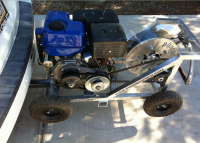








A winch is a mechanical device that is used to pull in (wind up) or let out (wind out) or otherwise adjust the ""tension"" of a rope or wire rope (also called ""cable"" or ""wire cable""). In its simplest form it consists of a spool and attached hand crank. In larger forms, winches stand at the heart of machines as diverse as tow trucks, steam shovels and elevators. The spool can also be called the winch drum. More elaborate designs have gear assemblies and can be powered by electric, hydraulic, pneumatic or internal combustion drives. Some may include a solenoid brake and/or a mechanical brake or ratchet and pawl device that prevents it from unwinding unless the pawl is retracted.
The first known reference to a winch is made in the writings of Herodotus of Halicarnassus on the persian wars in 480 B.C.E., in which wooden winches were used to tighten cables used in a bridge that crossed the Hellespont.The idea caught on quickly and within a hundred or so years the winch had reached Greek construction sites,though evidence suggests that it was invented by the Assyrians in the fifth century B.C.E.
A simple winch is used to wind rope or cable,but the tool has many more applications when fitted with a cleat to maintain tension and prevent the rope or cable from unwinding.Cleated winches have long served on boats and harborsides to keep ships and boats closely moored to docksides.They are important for lifting work on construction sites,enabling workers to complete tall projects in a fraction of the time otherwise required.
In medival times a cleated winch was an important component of the rack,a bedlike torture device designed to stretch a person by infinitely painful degrees.Cleated winches are used to raise flags on flagpoles and keep them aloft and mini winches also feature on the reels of fishing rods,allowing anglers to maiintain or release line tension when playing a fish.Winches are used by tow-trucks,and they play a vital role in hellicopter rescues ,safely extracting people from dangerous situations.